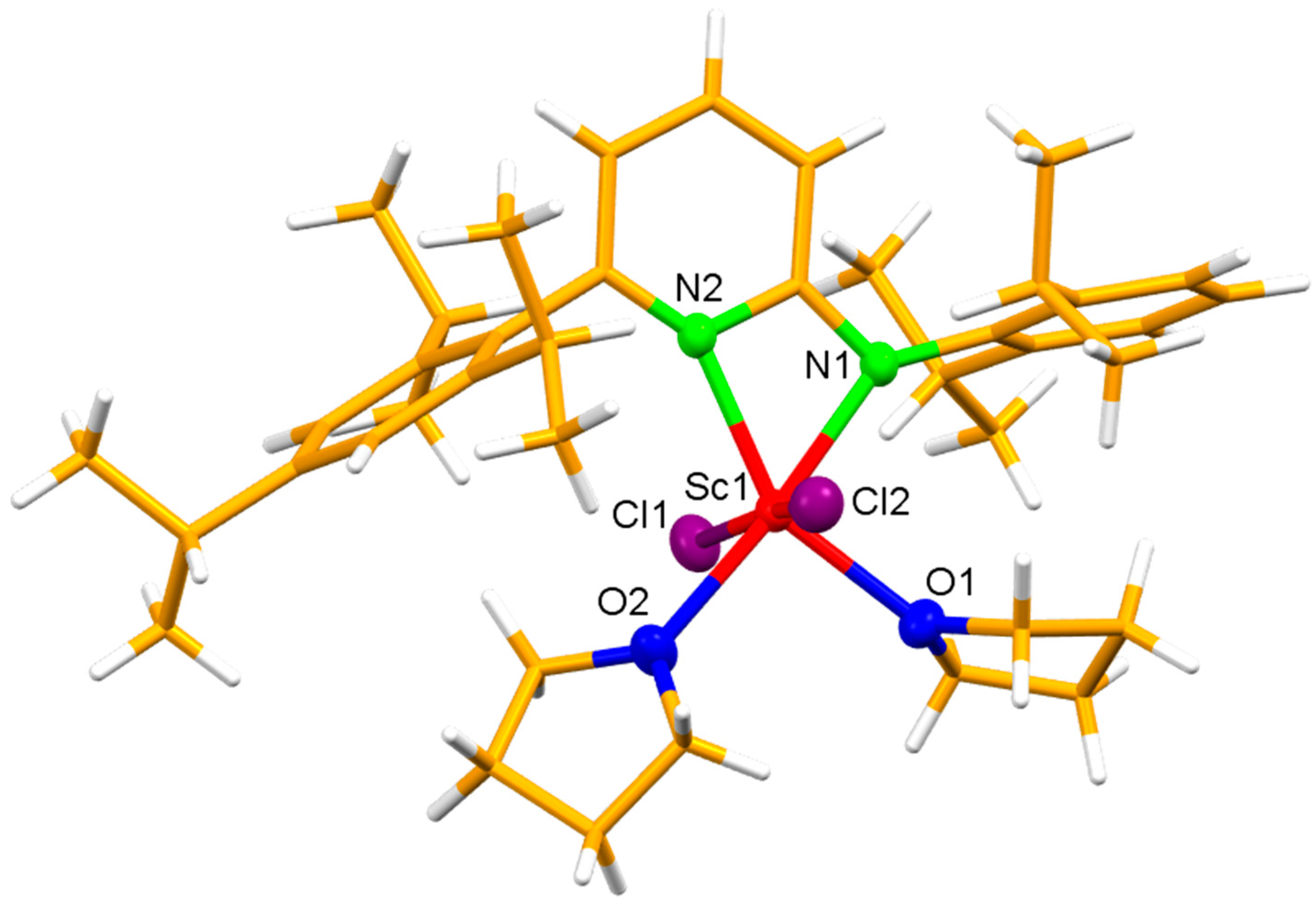The Synthesis and Structure of Scandium Dichloride of Sterically Demanding Aminopyridinato Ligands
Abstract
:1. Introduction
2. Results and Discussion
3. Experimental
4. Conclusions
Supplementary Materials
Funding
Data Availability Statement
Acknowledgments
Conflicts of Interest
References
- Kempe, R. The Strained η2-NAmido−NPyridine Coordination of Aminopyridinato Ligands. Eur. J. Inorg. Chem. 2003, 2003, 791–803. [Google Scholar] [CrossRef]
- Noor, A. Coordination chemistry of bulky aminopryridinates with main group and transition metals. Top. Curr. Chem. 2021, 379, 6. [Google Scholar] [CrossRef] [PubMed]
- Scott, N.M.; Schareina, T.; Tok, O.; Kempe, R. Lithium and potassium amides of sterically demanding aminopyridines. Eur. J. Inorg. Chem. 2004, 2004, 3297–3304. [Google Scholar] [CrossRef]
- Noor, A. Crystallographic Evidence of η1-Coordination of Bulky Aminopyridine in Halide-Containing Iron (II) Complexes. Crystals 2022, 12, 697. [Google Scholar] [CrossRef]
- Noor, A.; Wagner, F.R.; Kempe, R. Metal–Metal Distances at the Limit: A Coordination Compound with an Ultrashort Chromium–Chromium Bond. Angew. Chem. Int. Ed. 2008, 47, 7246–7249. [Google Scholar] [CrossRef] [PubMed]
- Noor, A.; Glatz, G.; Müller, R.; Kaupp, M.; Demeshko, S.; Kempe, R. Carboalumination of a chromium–chromium quintuple bond. Nat. Chem. 2009, 1, 322–325. [Google Scholar] [CrossRef] [PubMed]
- Noor, A.; Qayyum, S.; Schwarz, S.; Dietel, T.; Kempe, R. Formation of a dimeric tungsten(i) complex via C–H activation. Dalton Trans. 2020, 49, 1992–1996. [Google Scholar] [CrossRef] [PubMed]
- Kempe, R. Rare Earth Polymerization Catalysts Supported by Bulky Aminopyridinato Ligands. Z. Anorg. Allg. Chem. 2010, 636, 2135–2147. [Google Scholar] [CrossRef]
- Dietel, T.; Lukas, F.; Kretschmer, W.P.; Kempe, R. Elongation and branching of α-olefins by two ethylene molecules. Science 2022, 375, 1021–1024. [Google Scholar] [CrossRef] [PubMed]
- Kretschmer, W.P.; Meetsma, A.; Hessen, B.; Scott, N.M.; Qayyum, S.; Kempe, R. Lanthanum dibromide complexes of sterically demanding aminopyridinato and amidinate ligands. Z. Anorg. Allg. Chem. 2006, 632, 1936–1938. [Google Scholar] [CrossRef]
- Noor, S.Q.A.; Glatz, G.; Kempe, R.Z. Attempted Reduction of Divalent Rare Earth Iodo Aminopyridinates. Z. Anorg. Allg. Chem. 2009, 635, 2455–2458. [Google Scholar]
- Noor, A.; Kretschmer, W.; Kempe, R. Synthesis and Structure of Trialkyltantalum Complexes Stabilized by Aminopyridinato Ligands. Eur. J. Inorg. 2006, 2006, 2683–2689. [Google Scholar] [CrossRef]
- Qayyum, S. Syntheses and structural characterization of tris-and tetrakis (aminopyridinate) complexes of lanthanum. Inorg. Chim. Acta 2024, 559, 121768. [Google Scholar] [CrossRef]
- Glatz, G.; Demshko, S.; Motz, G.; Kempe, R. First Row Transition Metal Aminopyridinates–The Missing Complexes. Eur. J. Inorg. 2009, 2009, 1385–1392. [Google Scholar] [CrossRef]
- Döring, C.; Kretschmer, W.P.; Bauer, T.; Kempe, R. Scandium aminopyridinates: Synthesis, structure and isoprene polymerization. Eur. J. Inorg. Chem. 2009, 2009, 4255–4264. [Google Scholar] [CrossRef]
- Qayyum, S.; Skvortsov, G.G.; Fukin, G.K.; Trifonov, A.A.; Kretschmer, W.P.; Döring, C.; Kempe, R. Intramolecular C–H Bond Activation by Lanthanoid Complexes Bearing a Bulky Aminopyridinato Ligand. Eur. J. Inorg. Chem. 2010, 2010, 248–257. [Google Scholar] [CrossRef]
- Guillaume, S.M.; Schappacher, M.; Scott, N.M.; Kempe, R. Di- and trivalent rare earth complexes stabilized by sterically demanding aminopyridinato ligands as initiators in ring-opening polymerization reactions of ϵ-caprolactone. J. Polym. Sci. Part A Polym. Chem. 2007, 45, 3611–3619. [Google Scholar] [CrossRef]
- Turner, M.J.; McKinnon, J.J.; Wolff, S.K.; Grimwood, D.J.; Spackman, P.R.; Jayatilaka, D.; Spackman, M.A. Crystal Explorer 17; University of Western Australia: Perth, WA, Australia, 2017. [Google Scholar]
- Altomare, A.; Burla, M.C.; Camalli, M.; Cascarano, G.L.; Giacovazzo, C.; Guagliardi, A.; Moliterni, A.G.G.; Polidori, G.; Spagna, R. SIR97: A new tool for crystal structure determination and refinement. J. Appl. Crystallogr. 1999, 32, 115−119. [Google Scholar] [CrossRef]
- Sheldrick, G.M. A short history of SHELX. Acta Cryst. Sect. A 2008, 64, 112–122. [Google Scholar] [CrossRef]
- Farrugia, L.J. WinGX Suite for small-molecule single-crystal crystallography. J. Appl. Crystallogr. 1999, 32, 837−838. [Google Scholar] [CrossRef]





| Empirical Formula | C40H59Cl2N2O2Sc |
|---|---|
| Formula weight | 715.75 |
| Crystal system | monoclinic |
| Space group | P21/n |
| a [Å] | 12.4441(8) |
| b [Å] | 22.9975(10) |
| c [Å] | 13.9971(8) |
| α [deg] | |
| β [deg] | 92.297(5) |
| γ [deg] | |
| V, [Å3] | 4002.5(4) |
| Crystal size, [mm3] | 0.3 × 0.3 × 0.2 |
| ρcalcd, [g cm−3] | 1.188 |
| µ, [mm−1] (Mo Kα) | 0.351 |
| T, [K] | 193(2) |
| 2θ range, [deg] | 3.40–51.46 |
| No. of reflections (unique) | 7530 |
| No. of reflections obs. [I > 2σ (I)] | 6557 |
| No. of parameters | 424 |
| wR2 (all data) | 0.0966 |
| R-value [I > 2σ (I)] | 0.0376 |
Disclaimer/Publisher’s Note: The statements, opinions and data contained in all publications are solely those of the individual author(s) and contributor(s) and not of MDPI and/or the editor(s). MDPI and/or the editor(s) disclaim responsibility for any injury to people or property resulting from any ideas, methods, instructions or products referred to in the content. |
© 2024 by the author. Licensee MDPI, Basel, Switzerland. This article is an open access article distributed under the terms and conditions of the Creative Commons Attribution (CC BY) license (https://creativecommons.org/licenses/by/4.0/).
Share and Cite
Qayyum, S. The Synthesis and Structure of Scandium Dichloride of Sterically Demanding Aminopyridinato Ligands. Molbank 2024, 2024, M1805. https://doi.org/10.3390/M1805
Qayyum S. The Synthesis and Structure of Scandium Dichloride of Sterically Demanding Aminopyridinato Ligands. Molbank. 2024; 2024(2):M1805. https://doi.org/10.3390/M1805
Chicago/Turabian StyleQayyum, Sadaf. 2024. "The Synthesis and Structure of Scandium Dichloride of Sterically Demanding Aminopyridinato Ligands" Molbank 2024, no. 2: M1805. https://doi.org/10.3390/M1805






